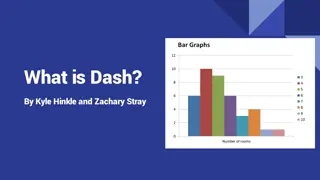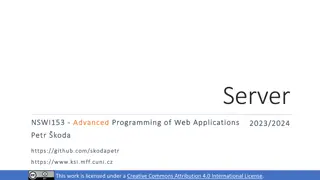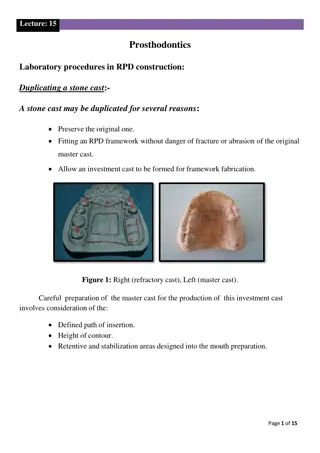
Web Application Development Using Flask Framework
Learn about Flask, a Python web application framework that simplifies web development by providing high-level abstractions and tools. Explore key concepts such as installation, creating Flask applications, routing, and running the application locally.
Download Presentation

Please find below an Image/Link to download the presentation.
The content on the website is provided AS IS for your information and personal use only. It may not be sold, licensed, or shared on other websites without obtaining consent from the author. If you encounter any issues during the download, it is possible that the publisher has removed the file from their server.
You are allowed to download the files provided on this website for personal or commercial use, subject to the condition that they are used lawfully. All files are the property of their respective owners.
The content on the website is provided AS IS for your information and personal use only. It may not be sold, licensed, or shared on other websites without obtaining consent from the author.
E N D
Presentation Transcript
LECTURE 13 WEB APPLICATION DEVELOPMENT WITH FLASK
What is Flask? Flask is a web application framework written in Python o a collection of libraries and modules that enables a web application developer to write applications without having to bother about low-level details such as protocols, thread management etc. o can be used to create front end (HTML5, CSS, jQuery or Javascript Created by an international Python community called Pocco, based on 2 other projects: o Werkzeug: A Web Server Gateway Interface (WSGI) that handles HTML requests, responses, etc. o Jinja2: a web templating system combining a template with data sources to render dynamic web pages. Adapted from Karen Works s COP4521 material, which in turn was adapted from: https://www.tutorialspoint.com/flask/flask_overview.htm
Installation Not in a typical Python installation See the official document: https://flask.palletsprojects.com/en/3.0.x/ Flask has been installed on linprog
FLASK application: Hello World Import the Flask class, an instance Of the class is the web application # Starting a web page at http://127.0.0.1:50000/ from flask import Flask app = Flask(__name__) Create the class instance @app.route('/') def hello_world(): return 'Hello World Route() decorator tells Flask the hello_world() function will be triggered When / in the website is accessed, the Web application will return the return value Of hello_world() to the web browser if __name__ == '__main__': app.run(host= 127.0.0.1 , port = 50000) After python3 FlaskHelloWorld.py linprog3 on linprog3. We can telnet do telnet linprog3 50000 and then issue GET / HTTP/1.0\r\n\r\n to see the Hello World response from the Flask website Start the website at port 50000 on the Local machine (127.0.0.1)
Flask Application The route() function tells the application which URL should call the associated function. app.route(rule, options) The rule parameter represents URL binding with the function. The options is a list of parameters to be forwarded to the underlying Rule object. In the example, / URL is bound with hello_world() function. Hence, when the home page of web server is opened in browser, the output of this function will be rendered.
Flask Application The run() method of Flask class runs the application on the local development server. app.run(host, port, debug, options) o Note : All parameters are optional o host: Hostname to listen on. Defaults to 127.0.0.1 (localhost). o port: defaults to 5000 o debug: defaults to false. If set to true, provides a debug information o options: to be forwarded to underlying (Werkzeug) server.
Flask Debug mode A Flask application is started by calling the run() method. However, while the application is under development, it should be restarted manually for each change in the code. To avoid this inconvenience, enable debug support. The server will then reload itself if the code changes. It will also provide a useful debugger to track the errors if any, in the application. The Debug mode is enabled by setting the debug property of the application object to True before running or passing the debug parameter to the run() method. app.debug = True app.run() app.run(debug = True)
Flask - routing The route() decorator in Flask is used to bind URL to a function. Here, URL /hello rule is bound to the hello_world() function. As a result, if a user visits http://localhost:5000/hello URL, the output of the hello_world() function will be rendered in the browser. # starting a web page at http://localhost:5000/hello from flask import Flask app = Flask(__name__) @app.route('/hello') def hello_world(): return 'Hello World' if __name__ == '__main__': app.run()
Flask Routing The add_url_rule() function of an application object is also available to bind a URL with a function as in the above example, route() is used. o First parameter is the rule, the third parameter is the function. The second parameter is called engpoint, which is the name of the route. def hello_world(): return 'Hello World' app.add_url_rule('/hello', 'hello_world', hello_world)
Flask Variable Rules in routing Flask variable rules allow for the creation of a dynamic URL by adding variable parts, to the rule parameter. o Dynamic URL: http://localhost:5000/guest/{guest_name} {guest_name} may be replace any guest name A variable rule can be defined by <variable-name> in the rule such as /guest/<name> . The variable must be passed as an argument to the function with which the rule is associated in Flask
Flask Variable Rules In the following example, the rule parameter of route() decorator contains <name> variable part attached to URL /hello . Hence, if the http://localhost:5000/hello/Test is entered as a URL in the browser, Test will be supplied to hello() function as argument. @app.route('/hello/<name>') def hello_name(name): return 'Hello %s !' %name
Flask Variable Rules There can be more than one variables in a rule as shown in the following example. All variables must be passed to the associated function @app.route('/posts/<post_id>/<slug> ) def show_post(post_id, slug): return f"Post {post_id} - Slug: {slug}"
Flask URL Building from flask import Flask, redirect, url_for app = Flask(__name__) Once we define the URL rules (patterns) and associate them with a function, we can reuse them in code and the templates. @app.route('/admin') def hello_admin(): return 'Hello Admin' @app.route('/guest/<guest>') def hello_guest(guest): return 'Hello %s as Guest' % guest @app.route('/user/<name>') def hello_user(name): if name =='admin': return redirect(url_for('hello_admin')) else: return redirect(url_for('hello_guest',guest = name)) if __name__ == '__main__': app.run(debug = True) url_for() function is useful for dynamically building a URL for a specific function. The function accepts the name of a function as first argument, and one or more keyword arguments, each corresponding to the variable part of URL.
Flask HTTP methods Sr.No . 1 Methods & Description GET /contact HTTP/1.1 Host: example.com User-Agent: curl/8.6.0 Accept: */* GET Sends data in unencrypted form to the server. Most common method. HEAD Same as GET, but without response body POST Used to send HTML form data to server. Data received by POST method is not cached by server. PUT Replaces all current representations of the target resource with the uploaded content. DELETE Removes all current representations of the target resource given by a URL 2 3 POST /test HTTP/1.1 Host: example.com Content-Type: application/x- www-form-urlencoded Content-Length: 27 4 5 field1=value1&field2=value2
Flask HTTP methods By default, the Flask route responds to the GET requests. This can be altered by providing methods argument to route() decorator. @app.route( /posts', methods=['GET', 'POST ]) def posts(): if request.methods == GET : return get the posts elif request.methods == POST : return make a new post For form submission, how to access the values in the form?
Let us review what we learn so far: Modify the following Flask code to run Flask web pages at http://www.cs.fsu.edu:10000/cop4521 and http://www.cs.fsu.edu:10000/cop4610 from flask import Flask app = Flask(__name__) @app.route('/') def hello_world(): return 'Hello World if __name__ == '__main__': app.run(host= 127.0.0.1 , port = 50000)
Modify the following Flask code to run dynamic Flask websites that allow each student to have a separate web page at http://www.cs.fsu.edu:10000/cop4521/<student_id> from flask import Flask app = Flask(__name__) @app.route('/') def hello_world(): return 'Hello World if __name__ == '__main__': app.run(host= 127.0.0.1 , port = 50000)
Modify the following Flask code to run a Flask website that can respond to http GET and PUT methods, http://www.cs.fsu.edu:10000/cop4521 from flask import Flask app = Flask(__name__) @app.route('/') def hello_world(): return 'Hello World if __name__ == '__main__': app.run(host= 127.0.0.1 , port = 50000)
What we know so far We can associate a URL with a python function. o The return value of the function will be sent back when a user access the URL. We can associate dynamic URLs with a function We can reuse the code with url_for() and redirect() We can respond to different HTTP requests (GET, POST, etc) Since Flask is intended to be used to build websites, the response needs to be in HTML! This is where Flask templates come into play!
Flask HELLO WORLD in HTML from flask import Flask app = Flask(__name__) @app.route('/') def index(): return '<html><body><h1>Hello World</h1></body></html>' if __name__ == '__main__': app.run(debug = True)
Flask Rendering HTML response using render_template() A HTML response can be rendered by the render_template() function. Render_template() takes an HTML template file as an argument o The HTML template file should be put in the subdirectory templates under the python source code. Application file structure: from flask import Flask, render_template o Application folder Hello.py app = Flask(__name__) @app.route('/') def index(): return render_template('hello.html') templates hello.html if __name__ == '__main__': app.run(debug = True) See FlaskRenderTemplateVer1
Flask Passing arguments to the HTML template Render_template() takes any number of keyword arguments. Accessing arguments in the HTML template with {{ argument name }} See FlaskRenderTemplateVer2 <!DOCTYPE html> <html lang="en"> <head> <meta charset="UTF-8"> <title>Title</title> </head> <body> <h1>Hello {{ name }}!</h1> </body> </html> from flask import Flask, render_template app = Flask(__name__) @app.route('/hello/<user>') def hello_name(user): return render_template('hello.html', name = user) if __name__ == '__main__': app.run(debug = True) Passing argument into the HTML template Accessing the argument in the HTML template
Flask More escapes from HTML in the HTML template. The jinja2 template engine uses the following delimiters for escaping from HTML. {% ... %} for Statements {{ ... }} for Expressions to print to the template output {# ... #} for Comments not included in the template output # ... ## for Line Statements <!doctype html> <html> <body> {% if marks>50 %} <h1> Your result is pass!</h1> {% else %} <h1>Your result is fail</h1> {% endif %} </body> </html> See FlaskRenderTemplateVer3
Flask Dynamic content in the HTML response Display a dynamic table (key-value pair) o For loop are enclosed in {%..%} whereas, the expressions key and value are put inside {{ }}. See FlaskRenderTemplateVer4 <!doctype html> <html> <body> <table border = 1> {% for key, value in result.items() %} <tr> <th> {{ key }} </th> <td> {{ value }} </td> </tr> {% endfor %} </table> </body> </html>
Flask More dynamic content in the HTML response See FlaskRenderTemplateVer5: Display a dynamic table <!doctype html> <html> <body> <table border = 1> {% for row in result) %} <tr> {% for item in row %} <td> {{ value }} </td> {% endfor %} </tr> {% endfor %} </table> </body> </html>
Flask Handle forms and interact with sqlite3 See ExampleCrapsSimpleFlaskWebsite <body> <form action="{{ url_for('addrec') }}" method="POST"> <h3>Player Information</h3> Name<br> <input type="text" name="Name" ><br> Age<br> <input type="text" name="Age"><br> Money<br> <input type="text" name="Money"><br> Password<br> <input type="password" name="Password"><br> <input type="submit" value="submit"><br> </form> </body> @app.route('/addrec',methods = ['POST', 'GET']) def addrec(): if request.method == 'POST': try: nm = request.form['Name'] ag = request.form['Age'] amt = request.form['Money'] pwd = request.form['Password ] . Put data in a sqlite3 database using SQL. ,,,


















